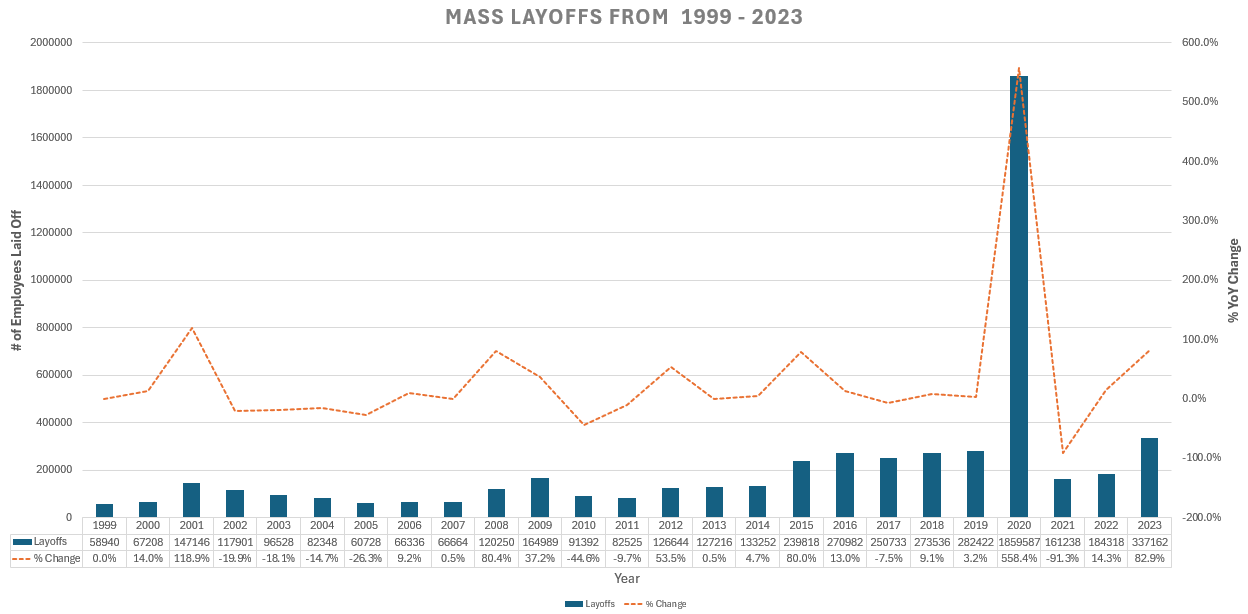The Worker Adjustment and Retraining Notification Act, also known as the WARN Act or Labor Code 1400-1408 LC, requires employers to notify their employees at least 60 days before any mass layoffs, plant closures, or major relocations. The legislation is designed to protect employees and their families as well as the communities that they support by giving both affected individuals and local community leaders time to prepare for big changes made by a large local employer. The overall purpose of this regulation is to give employees the opportunity to make plans and adjustments needed such as job hunting, retraining, or relocating. This act applies to private employers as well as government agencies and officials. If employers do not provide their employees with this advance notice, they are responsible for issuing back pay and benefits to their employees for the value of the lost time. This means that if an employer gave their employees 10 days’ notice, they owe those employees 50 days of pay and benefits.
What Notice Does the WARN Act Require Employers to Submit?
Employers are required to provide their employees with written notice at least 60 days prior to any:
- Mass Layoff – When an employer terminates 50 or more jobs due to a shortage of work or funds within a single 30 day period.
- Relocation – When an employer moves all or almost all of their commercial or industrial operations from one location to another that is 100 miles away or more.
- Plant Closure – When an employer completely or almost completely stops all or almost all industrial or commercial operations.
This notice may be given directly to employees or through a representative from the applicable state dislocated worker unit. In the state of California, this is the Employment Development Department, Workforce Services Division. California employers must also notify the Local Workforce Development Areas as well as the city and county chief elected officials for the location.
If your employment rights have been violated, call us today at (866) 936 7349 to schedule a free consultation
Who Does the WARN Act Protect?
The WARN act exists to protect employees who may be affected by a mass layoff of 50 or more employees, worksite relocation, or plant closure. The goal is to give those employees the time to prepare and adjust to the transition. In the state of California, employers must provide written notice 60 days prior to any mass layoffs, relocation, or closure if they have employed at least 75 full time or part time employees in the 12 months before that notice is due [1]. This includes employees who have been employed by the company for at least 6 out of the previous 12 months before the notice is to be given.
Why is the WARN Act Important?
The WARN Act helps laid off employees prepare for the future as well as provides them with the support and resources they need to transition while they find new employment. The COVID outbreak of 2020 really highlighted why the WARN Act is an important piece of legislation. During that period, there were an estimated 1.8 million layoffs [2] that occurred during the peak of COVID. Since then, the number of layoffs has dropped significantly but since 2021, mass layoffs and WARN notices have continued to increase year over year [3]. As of 2024, there have been an estimated 13,259 employees laid off in the state of California with those layoffs being preceded by 236 WARN notices [4].
The WARN Act is becoming more and more important with the number of employees that were recently impacted by mass layoffs increasing. In 2023, the number of impacted workers reached levels that were double what we saw during the 2001 and 2008 economic crashes. These recent layoffs are being impacted by several reasons that include increasing credit rates which make funding business operations harder [5], major corporations downsizing to avoid increasing labor costs [6], and job automation that is driven by artificial intelligence [7]. These emerging issues are putting downward pressure on the labor market which makes the WARN Act critical to ensuring a smoother transition for California citizens that are impacted.

When Does an Employer Need to File a WARN?
It is not enough that notice be sent 60 days prior to the event [8], the employees must actually receive the notice at least 60 days beforehand. It is important for employers to give themselves enough time to ensure that all employees have been notified properly and in the required time. Even if the date on the notice is 60 days before the mass layoff, relocation, or plant closing, the employer may still have to pay fines or compensate employees for lost wages if the notice is not received in time. If notifying employees directly, it may be wise to have signed confirmation of receipt.
What Happens After an Employer Files a WARN Notice?
The state of California responds to WARN notices by sending a rapid response team to help workers and employers navigate the transition that occurs before and after a mass layoff or plant closure. These teams are a joint effort between the Employment Development Department (EDD) and the America’s Job Center of California (AJCC) [9]. One way they help is to provide information and resources to employees that they can use to ensure they are able to properly prepare for their upcoming lapse in employment. These resources include materials from the AJCC, unemployment insurance programs, and resources from Title I of the Workforce Innovation and Opportunity Act (WIOA). Displaced workers can also qualify for the Trade Adjustment Assistance (TAA) program if their job is replaced by foreign competition. This program includes:
- Job training benefits
- Trade readjustment stipends
- Job hunt allowances
- Relocation stipends
- Employment services
- Alternative or reemployment trade adjustment support
How Can an Employer File a WARN Notice with Employees?
Employers have a few options for their method of informing employees of mass layoffs, relocations, and plant closures though it always must be in writing and given at least 60 days in advance. Notice can be sent [10]:
- Directly to each of the employees via first class mail
- With a notice in each employee’s paycheck
- In person delivery with an optional signed receipt
How Can an Employer File a WARN Notice with Regulatory Agencies?
To notify local regulatory agencies, employers planning mass layoffs must submit emails to the following agencies, boards, and officials. The emails must include the name of the employer, the WARN notice, and contact information. The WARN notice must be included as an attachment with the employer’s name listed directly in the subject line of the email.
- The Employment Development Department – Notice can be emailed to the EDD along with contact information to provide additional information or assistance.
- Local Workforce Development Board – Each city or county will have their own workforce development board with contact information to provide notice.
- Chief Elected Officials – Notice can be sent to the mayor or district supervisor of the area where the layoff, relocation, or plant closure is taking place. If there are multiple locations involved in different cities, the officials for each location should be notified.
What Should Be Included in the WARN Act Notice?
When drafting a WARN Act notice, employers must include the following WARN Act requirements [11]:
- The name of the company
- The address of the worksite location
- The name and contact information for a company official
- The specific timeframe in which layoffs, relocation, or closure will occur
- Whether the layoffs, relocation, or closure will be temporary or permanent
- Whether bumping rights exist
- A list of the positions and job titles that will be let go
- The number of employees being let go for each position
- A list of any and all unions representing the employees
- The names and contact information of the unions’ chief elected officers
If there are multiple worksites and locations being affected by the layoffs, relocation, or closure, then each location should have its own breakdown of affected employees, unions, and timeframe.
If your employment rights have been violated, call us today at (866) 936 7349 to schedule a free consultation
Exceptions to CA WARN Act Notice Requirements
As with many termination laws and regulations, there are some exceptions that may apply. There may be situations where an employer is unable to provide at least 60 days’ advance notice, or circumstances where advance notice is not necessary. The California WARN Act allows for a few reasonable exceptions [12].
Temp Work – When an employee is hired for a temporary job or seasonal assignment, they enter the employment relationship with an understanding that their employment will be terminated at a specific date or the completion of the specific project. Although it can be considered a mass layoff when the project or season comes to an end, a WARN Act notice is not needed because the employees were already informed at the beginning of their employment. There are many types of work that call for large quantities of employees to be hired and then let go all at once, such as:
- Movie set crews
- Seasonal resorts
- Crop harvesting
- Holiday retail
- Construction sites
War & Disaster – When an act of war, natural disaster, or other calamity forces a company to conduct a mass layoff, plant closure, or relocation, it may not be possible for the employer to give their employees advance notice. In these situations, those employers are not bound by the WARN Act.
Seeking Capital – Sometimes, layoffs, relocations, or closures are a last resort due to the impacts they have on business or seeking capital. In cases where an employer is trying to prevent this from happening, it may be too late to give enough notice when they are finally forced to take such action. An employer may be exempt from giving at least 60 days’ advance notice if they can prove all of the following:
- That the employer was actively seeking business or capital at the time when notice should have been given.
- Obtaining the business or capital would have prevented or postponed the layoffs, relocation, or closure from happening.
- That giving advance notice would have prevented the employer from obtaining business or capital, or that they reasonably believed in good faith that it would have.
Employer Responsibility and Liability
It is the responsibility of the employer to provide their employees with the proper warning 60 days prior to any mass layoff, relocation, or closure. If they fail to do so, they can face serious consequences. Employers can be fined up to $500 for each day the employer was in violation. They may also be responsible for compensating the employees for whatever wages that they would have received, including medical coverage for any illnesses or injuries that occur during the violation period. The back pay owed would be paid either at the final rate of pay or the rate of the 3 year average preceding the layoff, whichever was higher. Medical liabilities incurred would also be covered by employers for either any days in violation or WARN Act requirements or half of the days that the employee was working, whichever period was smaller [13] . However, if the employer did provide any wages during the violation period, that number of days paid would be subtracted from the total compensation the employee may be awarded.
What are the Primary Differences Between the Federal and California WARN Acts?
There is also a federal WARN Act that serves a similar purpose but has its own standards and regulations.
| Federal WARN Act | California WARN Act |
| Covers employers with 100 or more full time employees. Part time employees are only included if the number of hours worked by all part time employees exceeds 4,000 hours per week. | Covers employers with at least 75 part time or full time employees that were employed at any point in the previous 12 months before a WARN notice is filed |
| Mass layoffs are identified as at least 500 employees being laid off or at least 33% of employees with a minimum of 50 employees being laid off | Mass layoffs are identified as any 50 employees being laid off in a 30 day period |
| Plant closures involve 50 or more full time employees | Plant closure has no minimum requirement |
| WARN notice not required for jobs that were relocated and the employer offers replacement job at a new location within reasonable commuting distance, or the employee accepts a job at a new site regardless of distance | WARN notice is required for any relocation more than 100 miles away from current job site |
| Certain exceptions that unforeseen forced layoffs sue to events like natural disaster are permitted under federal WARN Act stipulations | Exceptions apply to workers that were hired for temporary work with an understanding that employment was limited or seasonal, layoffs that occur due to natural disaster or war, or when employers are actively seeking capital and have taken the appropriate steps with the Department of Industrial Relations |
| Violations result in employees being owed back pay and benefits for the violation period. | Violations result in employees being owed a $500 daily civil penalty and back pay at their final rate or previous 3 year average rate, whichever is higher, for the number of days in violation. Employers are also responsible for medical expenses incurred during the period in violation or half the days in which the employee was working, whichever number was less. |
Proposed Changes to the WARN Act
In Oct 2023, proposed assembly bill (AB) 1356 was vetoed by Governor Gavin Newsome [14]. The proposed bill would have required employers to provide employees with an additional 15 days’ notice in the event of a WARN Act triggering event like a mass layoff or plant closure. This bill would have also expanded the definition of employer to include “a client employer of a labor contractor” as well as expanded the definition of employee to include “a person employed by a labor contractor and performing labor with the client employer for at least 6 of the 12 months and for at least 60 hours preceding the date of which notice was required.” While this bill was vetoed, the increasing number of layoffs in recent years may result in the legal landscape becoming much more employee friendly. Employers may be looking at new requirements that they must comply with when navigating laying off employees in the future.
If your employment rights have been violated, call us today at (866) 936 7349 to schedule a free consultation
Contact Mesriani Law if You Believe You Were Part of a Mass Layoff
There are many factors that can lead to a company downsizing, moving, or closing a worksite. Regardless of the reason, it is a stressful ordeal for the employees affected. The WARN Act exists to help cushion the blow and give those employees the time to adjust and adapt. Unfortunately, employers do not always comply with the law. When employees are subjected to mass layoffs without sufficient notice, they have a right to take legal action against their employer. This can be a complicated and arduous process to take on during an already stressful time and seeking help from an employment lawyer can be extremely beneficial in these situations. If you have lost your job due to a mass layoff, relocation, or closure and were not given at least 60 days’ advance notice, call Mesriani Law Group today. Our office is in Santa Monica and we provide legal expertise to Los Angeles and the rest of Southern California. Our team of expert employment attorneys are ready to provide you with a free consultation.
Sources
[1] https://careerminds.com/blog/warn-act-in-california#What_Is_the_WARN_Act_in_California [2] [3] [4] https://www.warntracker.com/?state=CA&year=2024 [5] https://www.newsweek.com/us-layoffs-california-new-york-washington-tech-hospitality-healthcare-job-cuts-1875648 [6] https://www.cbsnews.com/news/doordash-pizza-hut-minimum-wage-hikes-california-new-york-city/ [7] https://edition.cnn.com/2023/07/04/tech/ai-tech-layoffs/index.html [8] https://workforce.org/warns/ [9] [10] [11] [12] [13] https://edd.ca.gov/en/jobs_and_training/layoff_services_warn [14] https://www.natlawreview.com/article/governor-newsom-vetoes-bill-would-have-given-california-employees-earlier-layoff
WARN Act FAQs
What is the WARN Act in California?
The Worker Adjustment and Retraining Notification Act is a regulation in place to protect workers in the event of a mass layoff, plant closure, or relocation. It requires that employers give their employees 60 days of advance notice so that they can make whatever plans or adjustments needed to find new employment. The California WARN Act applies to a wider range of employers than the federal law and imposes larger penalties for violations.
What triggers the California WARN Act?
If a California employer implements a mass layoff, closure, or relocation, they must give the affected employees prior notice at least 60 days in advance. A mass layoff is defined in California law as the termination of 50 or more employees within a period of 30 days. A closure is when an employer terminates all or almost all operations at a worksite. A relocation is when an employer moves all or almost all operations by 100 miles or more. There are some exceptions to this requirement such as temporary employment and layoffs, closures, and relocations that are caused by natural disasters.
Does California have a mini WARN Act?
The federal WARN Act was passed in 1988 to protect employees affected by mass layoffs, plant closures, and relocations. California has its own version which was passed in 2003 and serves the same purpose with its own requirements, exceptions, and penalties. The California WARN Act does not contradict the federal law, it simply adds to it, affording protections to a wider range of employees.
What is the difference between warn and CA warn?
There are many similarities between the federal and California WARN Acts, but there are also several differences including:
Federal WARN Act
• Applies to employers with at least 100 employees
• Does not count most part time workers
• Applies to layoffs of at least 33% of full time workers with a minimum of 50 employees
• Applies to plant closures affecting at least 50 employees
• Violating employers may be liable for back pay
• Exceptions are made for unforeseeable business circumstances
California WARN Act
• Applies to employers with at least 75 employees during the 12 months prior to notice
• Includes part time workers
• Applies to layoffs of at least 50 employees regardless of percentage
• Applies to plant closures affecting any employees
• Violating employers may be liable for $500 per day of violation, back pay, and benefits
• There are no exceptions for unforeseeable business circumstances








